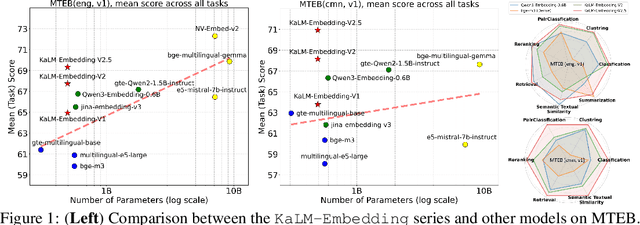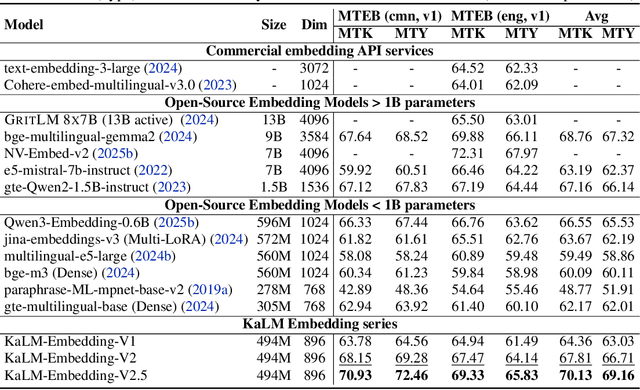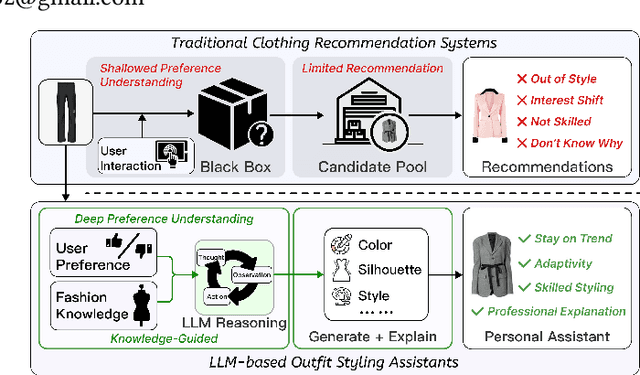Haofen Wang
CitySeeker: How Do VLMS Explore Embodied Urban Navigation With Implicit Human Needs?
Dec 18, 2025Abstract:Vision-Language Models (VLMs) have made significant progress in explicit instruction-based navigation; however, their ability to interpret implicit human needs (e.g., "I am thirsty") in dynamic urban environments remains underexplored. This paper introduces CitySeeker, a novel benchmark designed to assess VLMs' spatial reasoning and decision-making capabilities for exploring embodied urban navigation to address implicit needs. CitySeeker includes 6,440 trajectories across 8 cities, capturing diverse visual characteristics and implicit needs in 7 goal-driven scenarios. Extensive experiments reveal that even top-performing models (e.g., Qwen2.5-VL-32B-Instruct) achieve only 21.1% task completion. We find key bottlenecks in error accumulation in long-horizon reasoning, inadequate spatial cognition, and deficient experiential recall. To further analyze them, we investigate a series of exploratory strategies-Backtracking Mechanisms, Enriching Spatial Cognition, and Memory-Based Retrieval (BCR), inspired by human cognitive mapping's emphasis on iterative observation-reasoning cycles and adaptive path optimization. Our analysis provides actionable insights for developing VLMs with robust spatial intelligence required for tackling "last-mile" navigation challenges.
Thinker: Training LLMs in Hierarchical Thinking for Deep Search via Multi-Turn Interaction
Nov 14, 2025



Abstract:Efficient retrieval of external knowledge bases and web pages is crucial for enhancing the reasoning abilities of LLMs. Previous works on training LLMs to leverage external retrievers for solving complex problems have predominantly employed end-to-end reinforcement learning. However, these approaches neglect supervision over the reasoning process, making it difficult to guarantee logical coherence and rigor. To address these limitations, we propose Thinker, a hierarchical thinking model for deep search through multi-turn interaction, making the reasoning process supervisable and verifiable. It decomposes complex problems into independently solvable sub-problems, each dually represented in both natural language and an equivalent logical function to support knowledge base and web searches. Concurrently, dependencies between sub-problems are passed as parameters via these logical functions, enhancing the logical coherence of the problem-solving process. To avoid unnecessary external searches, we perform knowledge boundary determination to check if a sub-problem is within the LLM's intrinsic knowledge, allowing it to answer directly. Experimental results indicate that with as few as several hundred training samples, the performance of Thinker is competitive with established baselines. Furthermore, when scaled to the full training set, Thinker significantly outperforms these methods across various datasets and model sizes. The source code is available at https://github.com/OpenSPG/KAG-Thinker.
JoyAgent-JDGenie: Technical Report on the GAIA
Oct 01, 2025Abstract:Large Language Models are increasingly deployed as autonomous agents for complex real-world tasks, yet existing systems often focus on isolated improvements without a unifying design for robustness and adaptability. We propose a generalist agent architecture that integrates three core components: a collective multi-agent framework combining planning and execution agents with critic model voting, a hierarchical memory system spanning working, semantic, and procedural layers, and a refined tool suite for search, code execution, and multimodal parsing. Evaluated on a comprehensive benchmark, our framework consistently outperforms open-source baselines and approaches the performance of proprietary systems. These results demonstrate the importance of system-level integration and highlight a path toward scalable, resilient, and adaptive AI assistants capable of operating across diverse domains and tasks.
KaLM-Embedding-V2: Superior Training Techniques and Data Inspire A Versatile Embedding Model
Jun 26, 2025



Abstract:In this paper, we propose KaLM-Embedding-V2, a versatile and compact embedding model, which achieves impressive performance in general-purpose text embedding tasks by leveraging superior training techniques and data. Our key innovations include: (1) To better align the architecture with representation learning, we remove the causal attention mask and adopt a fully bidirectional transformer with simple yet effective mean-pooling to produce fixed-length embeddings; (2) We employ a multi-stage training pipeline: (i) pre-training on large-scale weakly supervised open-source corpora; (ii) fine-tuning on high-quality retrieval and non-retrieval datasets; and (iii) model-soup parameter averaging for robust generalization. Besides, we introduce a focal-style reweighting mechanism that concentrates learning on difficult samples and an online hard-negative mixing strategy to continuously enrich hard negatives without expensive offline mining; (3) We collect over 20 categories of data for pre-training and 100 categories of data for fine-tuning, to boost both the performance and generalization of the embedding model. Extensive evaluations on the Massive Text Embedding Benchmark (MTEB) Chinese and English show that our model significantly outperforms others of comparable size, and competes with 3x, 14x, 18x, and 26x larger embedding models, setting a new standard for a versatile and compact embedding model with less than 1B parameters.
OneEval: Benchmarking LLM Knowledge-intensive Reasoning over Diverse Knowledge Bases
Jun 14, 2025



Abstract:Large Language Models (LLMs) have demonstrated substantial progress on reasoning tasks involving unstructured text, yet their capabilities significantly deteriorate when reasoning requires integrating structured external knowledge such as knowledge graphs, code snippets, or formal logic. This limitation is partly due to the absence of benchmarks capable of systematically evaluating LLM performance across diverse structured knowledge modalities. To address this gap, we introduce \textbf{\textsc{OneEval}}, a comprehensive benchmark explicitly designed to assess the knowledge-intensive reasoning capabilities of LLMs across four structured knowledge modalities, unstructured text, knowledge graphs, code, and formal logic, and five critical domains (general knowledge, government, science, law, and programming). \textsc{OneEval} comprises 4,019 carefully curated instances and includes a challenging subset, \textsc{OneEval}\textsubscript{Hard}, consisting of 1,285 particularly difficult cases. Through extensive evaluation of 18 state-of-the-art open-source and proprietary LLMs, we establish three core findings: a) \emph{persistent limitations in structured reasoning}, with even the strongest model achieving only 32.2\% accuracy on \textsc{OneEval}\textsubscript{Hard}; b) \emph{performance consistently declines as the structural complexity of the knowledge base increases}, with accuracy dropping sharply from 53\% (textual reasoning) to 25\% (formal logic); and c) \emph{diminishing returns from extended reasoning chains}, highlighting the critical need for models to adapt reasoning depth appropriately to task complexity. We release the \textsc{OneEval} datasets, evaluation scripts, and baseline results publicly, accompanied by a leaderboard to facilitate ongoing advancements in structured knowledge reasoning.
Synergizing RAG and Reasoning: A Systematic Review
Apr 22, 2025



Abstract:Recent breakthroughs in large language models (LLMs), particularly in reasoning capabilities, have propelled Retrieval-Augmented Generation (RAG) to unprecedented levels. By synergizing retrieval mechanisms with advanced reasoning, LLMs can now tackle increasingly complex problems. This paper presents a systematic review of the collaborative interplay between RAG and reasoning, clearly defining "reasoning" within the RAG context. It construct a comprehensive taxonomy encompassing multi-dimensional collaborative objectives, representative paradigms, and technical implementations, and analyze the bidirectional synergy methods. Additionally, we critically evaluate current limitations in RAG assessment, including the absence of intermediate supervision for multi-step reasoning and practical challenges related to cost-risk trade-offs. To bridge theory and practice, we provide practical guidelines tailored to diverse real-world applications. Finally, we identify promising research directions, such as graph-based knowledge integration, hybrid model collaboration, and RL-driven optimization. Overall, this work presents a theoretical framework and practical foundation to advance RAG systems in academia and industry, fostering the next generation of RAG solutions.
Search is All You Need for Few-shot Anomaly Detection
Apr 16, 2025



Abstract:Few-shot anomaly detection (FSAD) has emerged as a crucial yet challenging task in industrial inspection, where normal distribution modeling must be accomplished with only a few normal images. While existing approaches typically employ multi-modal foundation models combining language and vision modalities for prompt-guided anomaly detection, these methods often demand sophisticated prompt engineering and extensive manual tuning. In this paper, we demonstrate that a straightforward nearest-neighbor search framework can surpass state-of-the-art performance in both single-class and multi-class FSAD scenarios. Our proposed method, VisionAD, consists of four simple yet essential components: (1) scalable vision foundation models that extract universal and discriminative features; (2) dual augmentation strategies - support augmentation to enhance feature matching adaptability and query augmentation to address the oversights of single-view prediction; (3) multi-layer feature integration that captures both low-frequency global context and high-frequency local details with minimal computational overhead; and (4) a class-aware visual memory bank enabling efficient one-for-all multi-class detection. Extensive evaluations across MVTec-AD, VisA, and Real-IAD benchmarks demonstrate VisionAD's exceptional performance. Using only 1 normal images as support, our method achieves remarkable image-level AUROC scores of 97.4%, 94.8%, and 70.8% respectively, outperforming current state-of-the-art approaches by significant margins (+1.6%, +3.2%, and +1.4%). The training-free nature and superior few-shot capabilities of VisionAD make it particularly appealing for real-world applications where samples are scarce or expensive to obtain. Code is available at https://github.com/Qiqigeww/VisionAD.
StePO-Rec: Towards Personalized Outfit Styling Assistant via Knowledge-Guided Multi-Step Reasoning
Apr 14, 2025



Abstract:Advancements in Generative AI offers new opportunities for FashionAI, surpassing traditional recommendation systems that often lack transparency and struggle to integrate expert knowledge, leaving the potential for personalized fashion styling remain untapped. To address these challenges, we present PAFA (Principle-Aware Fashion), a multi-granular knowledge base that organizes professional styling expertise into three levels of metadata, domain principles, and semantic relationships. Using PAFA, we develop StePO-Rec, a knowledge-guided method for multi-step outfit recommendation. StePO-Rec provides structured suggestions using a scenario-dimension-attribute framework, employing recursive tree construction to align recommendations with both professional principles and individual preferences. A preference-trend re-ranking system further adapts to fashion trends while maintaining the consistency of the user's original style. Experiments on the widely used personalized outfit dataset IQON show a 28% increase in Recall@1 and 32.8% in MAP. Furthermore, case studies highlight improved explainability, traceability, result reliability, and the seamless integration of expertise and personalization.
ReSearch: Learning to Reason with Search for LLMs via Reinforcement Learning
Mar 27, 2025



Abstract:Large Language Models (LLMs) have shown remarkable capabilities in reasoning, exemplified by the success of OpenAI-o1 and DeepSeek-R1. However, integrating reasoning with external search processes remains challenging, especially for complex multi-hop questions requiring multiple retrieval steps. We propose ReSearch, a novel framework that trains LLMs to Reason with Search via reinforcement learning without using any supervised data on reasoning steps. Our approach treats search operations as integral components of the reasoning chain, where when and how to perform searches is guided by text-based thinking, and search results subsequently influence further reasoning. We train ReSearch on Qwen2.5-7B(-Instruct) and Qwen2.5-32B(-Instruct) models and conduct extensive experiments. Despite being trained on only one dataset, our models demonstrate strong generalizability across various benchmarks. Analysis reveals that ReSearch naturally elicits advanced reasoning capabilities such as reflection and self-correction during the reinforcement learning process.
Enhancing Environmental Robustness in Few-shot Learning via Conditional Representation Learning
Feb 03, 2025



Abstract:Few-shot learning (FSL) has recently been extensively utilized to overcome the scarcity of training data in domain-specific visual recognition. In real-world scenarios, environmental factors such as complex backgrounds, varying lighting conditions, long-distance shooting, and moving targets often cause test images to exhibit numerous incomplete targets or noise disruptions. However, current research on evaluation datasets and methodologies has largely ignored the concept of "environmental robustness", which refers to maintaining consistent performance in complex and diverse physical environments. This neglect has led to a notable decline in the performance of FSL models during practical testing compared to their training performance. To bridge this gap, we introduce a new real-world multi-domain few-shot learning (RD-FSL) benchmark, which includes four domains and six evaluation datasets. The test images in this benchmark feature various challenging elements, such as camouflaged objects, small targets, and blurriness. Our evaluation experiments reveal that existing methods struggle to utilize training images effectively to generate accurate feature representations for challenging test images. To address this problem, we propose a novel conditional representation learning network (CRLNet) that integrates the interactions between training and testing images as conditional information in their respective representation processes. The main goal is to reduce intra-class variance or enhance inter-class variance at the feature representation level. Finally, comparative experiments reveal that CRLNet surpasses the current state-of-the-art methods, achieving performance improvements ranging from 6.83% to 16.98% across diverse settings and backbones. The source code and dataset are available at https://github.com/guoqianyu-alberta/Conditional-Representation-Learning.
 Add to Chrome
Add to Chrome Add to Firefox
Add to Firefox Add to Edge
Add to Edge